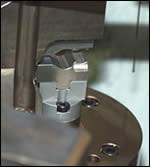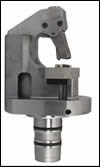Complete In One Chucking
Compared to barstock, castings, forgings and sawn blanks present a different set of workhandling challenges for production machining. This article looks at how Hydromat Inc. is meeting these challenges on its rotary transfer machines with engineered indexing workholders.
Machining castings with irregular shapes and a number of features is always a challenge. Doing them in large quantities with extremely tight tolerances can cause even more problems. These high-volume applications can be especially troublesome when secondary operations are required, and the occasional flawed casting can cause a host of issues. Money is wasted in manpower and material as productivity falters. There is an answer. The methodology is that of “single-clamping with no secondary operations.” This is easier said than done, especially when these castings need to be produced in large quantities, fast.
Getting At The Work
The addition of indexing chucks to a rotary transfer machine can increase productivity and the accuracy of features on cast workpieces requiring machining on multiple surfaces for production of a variety of parts for some industries including plumbing, fittings, automotive, and almost anything that has irregular shapes with a number of features.
Hydromat offers an indexing chuck type rotary transfer machine with 16 or 12 horizontal cutting stations and eight or six vertical cutting stations, respectively. The chucks are positioned on the rotary table in a satellite arrangement and are indexed hydraulically. The 12-station machine has a 4-inch work cube, and the 16-station can accommodate a 3-inch cube.
In some instances, depending on the workpiece, these work envelopes may be increased. The machine model and indexing requirements are taken into consideration at the preliminary engineering stages, and some creative solutions have been reached in the past.
One solution may be the use of a double-index configuration consisting of two different types of chucks alternating in the satellite configuration. After each machining cycle, the table will index two positions, bringing a second specially designed chuck into position to clamp the second side of the workpiece.
Actuating The Chucks
The indexing chuck machines are available in the classic hydraulic-driven machines as well as the Hydromat Epic R/T, the CNC-controlled version. With the classic format, the chucks use mechanical indexers, while the Epic line uses programmable servo indexers with chuck position determined at the control pendant using Epic software. In both instances, chucks can be indexed in increments of 5 degrees.
Each chuck has its own coupling giving each of the 12 or 16 positions high repeatability. To access angles that are outside the 5-degree range, the cutting unit is angled to create that feature’s position.
Holding Most Of The Work
Two standard two-jaw chucks are available in 140-mm and 160-mm sizes for round, hex or square stock as well as castings or housings in any shape or form that allow for clamping within the available range. The standard two-jaw chuck configuration accounts for 75 to 80 percent of the applications on the rotary transfer.
The machines use a self-centering chuck design providing the necessary repeatability to hold the tight part requirements. A pull piston works from the center of the chuck, pulling the two jaws the same distance at the same force to center the part.
All chucks can have the pressure adjusted to provide the appropriate grip for that operation. The accuracy of this clamping method is 2 to 5 microns. “Using ground stock as a blank will repeat with less than a 5-micron variance on a consistent basis,” says Rodger Boswell, Hydromat’s director of sales.
Each chuck is ground to the same height and centerline position for maximum accuracy. Performed in-house, the company’s technicians have the ability to grind in each workholding fixture so the workpiece will be in exactly the same place, position to position.
When grinding the position on a set of chucks, they can also adjust for the axis orientation of the part. This is extremely important for perpendicular
accuracy.
These indexing chuck systems can potentially machine five sides at once, then re-insert for the sixth side, depending on the placement of the features. With the most common approach, the jaws will cover two sides, so after inverting, the next set of machining operations are performed on sides four, five and six.
A stepped jaw fixture allows for inverting and relocating of the part into the same chuck in a different set of contact locations. In other cases a double-index system is created. Two sets of chucks, specially designed for the castings’ unique features, are placed at alternate positions on the table.
After the first set of operations are complete, the part is picked, the table indexes and the irregular-shaped workpiece is inserted into the second chuck to complete the transfer process. Most of the chuck jaws specified are hydraulically actuated, but other types may be used when the application requires them.
An example is a spring-loaded or flex jaw- (deflection) type chuck that has clamping force built into the chuck. A jaw is spread apart with a wedge and then allowed to collapse back on the workpiece—no moving parts are used on the fixture, which yields a high repeatability factor.
Custom Chucks
Custom chucks are used when the features and part configuration doesn’t allow for the use of the standard chucks. “Custom chuck machines are required when certain reference points on the workpiece won’t allow for the conventional two-jaw chuck. The part may need to be placed in a certain way, and when the two-jaw chuck won’t allow for that, we create a special clamping fixture to get the job done,” notes Martin Weber, vice president of manufacturing. The company designs these special fixtures around the part features using locating pins or a fixed (machined) surface.
With a casting, the initial machined surface becomes the precision location for the additional cutting operations. This initial location may be a milled surface that would locate on a stationary chuck jaw, or it may be initial drilled holes that would locate pins. A stationary surface provides the positioning surface, then a second moving jaw clamps the workpiece against that fixed surface. This holds the tolerance and maintains the setup dimensions while giving extremely accurate repeatability without relying on the cast surface for accuracy.
“Now we’re positioning on a machined-to-machined surface, not on the cast surface. That’s where the accuracy comes in,” Mr. Weber explains. “We can also do fixture error mapping with the CNC multi-axis tool spindle flanges. All these things combined result in repeatability, holding industry-prescriptive statistical indices of 1.33, 1.67 and 2.0 Cpk.”
Flaws in castings always present special challenges. “You can work around it, or with it. Surface to machined surface is the way to approach it, a one-jaw chuck that seats the part on a stationary surface—we engineer with the flaws rather than against them. That’s where a good fixture design and experience comes in,” Mr. Weber says.
Family Matters
For a family of parts where a different workpiece position is required, chucks can be designed with quick-change inserts that accommodate small changes from part to part. A change-over for another part in a family may only require a chuck jaw insert change. One bolt for each chuck keeps the change to a minimum (one hour or less).
For chucks designed with two gripping surfaces, 20 minutes would be sufficient for a tooling change and to bring up the next part program in the series. When engineering for a family of parts, a second index unit may be added for additional flexibility.
Flexible Feeding
Indexing chuck machines can be configured to hold virtually any shape within the work envelope. Many of these chuck-type machines go out the door configured with a bar feeder.
Later, these machines may run production by feeding a cast part with a robot or a “pick and place” gantry-type system. Robots are becoming more and more popular for the loading of this type of machine because of flexibility and lowering costs of the units themselves. In many applications that are dedicated or for families of parts, Hydromat engineers design a gantry-fed pallet system, or a hopper type that feeds a magazine. Later, the bar feeder is still available for a barstock application.
Changing Markets
As the marketplace has required more complex parts with tighter tolerances, the Hydromat HS machine sales have shifted. The indexing chuck machines have become a more viable configuration in recent years.
More complex parts require the flexibility that these machines provide. A majority of these applications are engineered for machines in the field of automotive components, with an increasing number of machines being built for the plumbing and connector industries as well as for defense and aerospace.
“We look at each project and develop a process for the application. Everything has its niche. For castings and irregular shapes, the HS, with properly designed indexing workholding, may well be the answer for repeatability and volume production,” says Mr. Boswell. “It’s something to think about.”
Related Content
What’s the Right Bar Feeder for Your Machine Shop?
Machine shops likely have questions about what type of bar feeder makes most sense for their operational needs. One or more of these four might be floating around in your head.
Read MoreThe Workholding is the Hardest Part
Finding a way to fixture contoured marine propellors proved to be this shop’s biggest challenge in developing an effective automated machining and turning cell.
Read MorePrecision Machining Technology Review: December 2024
Production Machining’s December 2024 technology showcase includes some of the latest technology from Hexagon, Kennametal, SmartCAM, Horn and SMW Autoblok.
Read MoreChuck Jaws Achieve 77% Weight Reduction Through 3D Printing
Alpha Precision Group (APG) has developed an innovative workholding design for faster spindle speeds through sinter-based additive manufacturing.
Read MoreRead Next
Rotary Transfer Machine’s Flexibility Spurs Shop’s Growth
Initially purchased for a high-volume job, this rotary transfer machine proves an efficient tool for short- to medium-run family-of-parts jobs as well.
Read MoreA Tooling Workshop Worth a Visit
Marubeni Citizen-Cincom’s tooling and accessory workshop offers a chance to learn more about ancillary devices that can boost machining efficiency and capability.
Read More

.jpg;maxWidth=150;quality=70)












.jpg;maxWidth=300;quality=90)






.jpg;maxWidth=400;quality=70)

